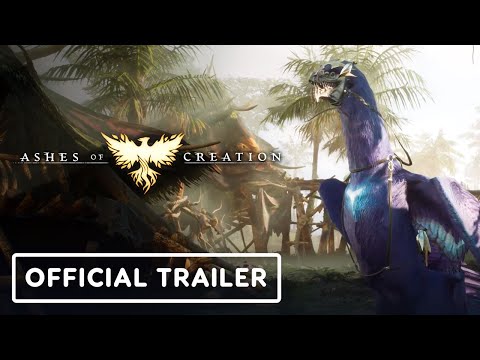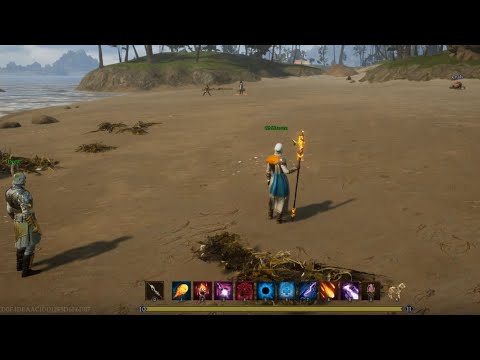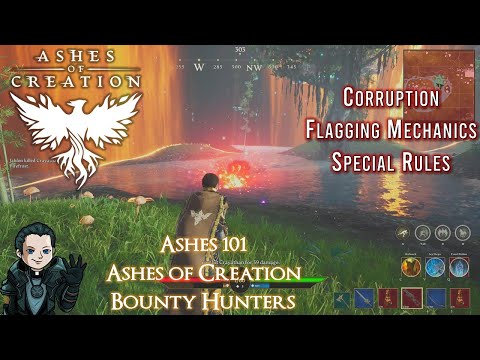There’s no official release date yet. However, developers are giving access to their various test versions. Each test will include further changes, tweaks, and improvements. That means whatever I say may not exist when the online RPG makes its final debut. So, instead of a standard review, I’ll be talking about what the game intends to offer. For now, you can compare Ashes of Creation with our recent New World review and see which of these newer MMORPGs is worthy of your time and money. Ashes of Creation is available for Windows. Indie developers Intrepid Studios are making their debut with this game.
Can You Play Ashes of Creation?
The MMORPG is currently on “Alpha One Test,” which came out on July 21, 2021. You can gain access to the Alpha and further test versions by backing the game on Kickstarter Particular content creators and streamers may get an invitation as well. Lastly, developers seldom giveaway access codes to their followers via their Discord channels. After the Alpha One Test, developers will launch Alpha Two, Beta One, and Beta Two. You would have to buy the supporter packages on their site to get access to further tests. Some of these are widely expensive, but they include gear, cosmetics, and more. That said, there’s no simple pre-purchase option available.
What is Ashes of Creation?
Ashes of Creation is a free-roam MMORPG. The world structure is dynamic and reacts to player actions, or so the developer promises. The game takes place in the fictional world of Verra. It’s a large, high medieval fantasy open-world that changes according to what the players do. So far, that means cities grow and develop as players move further down the quest paths. In particular, finding secrets and completing quests unlocks populations, important NPCs, and city features. The NPC structure happens in real-time so that players can create and destroy its elements. The other side of the coin is the political intrigue, which is part of the main questline. It has a crucial role in your experience and the lore.
Evolving World
Developers promise the world will continuously evolve, so your experience won’t be static or dependent on continuous updates. Outside of the starter cities, the open world is full of locations that can grow or disappear. For example, locations start as villages and then become towns, cities, and empires. Or, say, a small wooden outpost could turn into a fortified castle. Similarly, you may also purchase plots to own land within the world. Another element that will keep the world alive is trade routes. You can arrange trade routes, protect caravans, or loot caravans. These offer the resources you’d need to create defensive positions.
Questing
Questing was not a big part of the Alpha One Test; it was more of a “placeholder.” By that, I mean empty spaces that will have a quest in further versions. Still, there’re over 200 missions so far. Missions might be Events, Jobs, or Narrative Quests. These are the core of your PvE content, but the current version has about 10% or less of what developers intend. For example, there’re several dungeons in the game but no other instances to visit. Still, whereas Ashes of Creation is an open-world title, there’s going to be some dungeon-crawling involved, with a functionality akin to WoW raids. That means dungeons are significant quest or loot areas with a boss at the end of the location. You’d require to go with a party to complete the instance.
Itemization
Characters have 16 gear slots, including 2 weapons, five jewelry pieces, eight armor slots, and a space for a ranged weapon. Gear comes in various levels or tiers. However, there’re no stat, class, or race requirements to use armor, weapons, or jewelry. There’re, though, affiliation requirements. (Affiliations are temporary factions that determine ally and enemy NPC entities). That said, gear has its own progression system. You can use weapon combos or spec into specific weapon abilities that change the available combos. You could also enhance your gear with Power Stones or improve your weapons with your passive skills.
Open-world PvP
The game boasts a hefty PvP design. You may or may not like it, but you should know Ashes of Creation offers one of the largest, if not the biggest, open-world PvP in the industry. Outside of the starter areas and other places, you can combat against anyone you see. It’s almost like a free-for-all PvP game, as there’re no pre-determined factions in the game. Instead of factions, there’s a flag system that separates enemies from friends. However, you may or may not respect the system. With the flag system, players have three states. White means you’re an innocent player, not willing to do any PvP. The purple flag labels you as someone willing to fight. Finally, the Red flag refers to players who have slain innocent “white” players. Furthermore, you may choose to participate in large-scale battles to assault critical NPC areas in the world. These battles further change the land and revolve around castles, cities, hunting grounds, or caravans. On top of this, there’re static, standard PvP areas where you can test your skills and build against other players. During the Alpha Test One, though, the available map had about 17% the size of the actual map. We’ve seen only a couple of villages, and they grew and changed as players continued playing within the server.
Critical PvP Mechanics
Developers state PvP is the element that influences their world the most. Player combat is part of critical questlines, and so it will change essential elements of the world. For example, strategic castles may change hands, or trade caravans could change routes. More importantly, PvP yields various rewards. Because resources are scarce globally, players need to combat against each other to control trade routes, caravans, and hunting grounds. Moreover, you get 50% of your victim’s loot and gear. Frequently, the game may ask you to participate in a large-scale battle. These are siege wars for control of critical areas. There’re no death penalties for dying on objective-based PvP events. Here’s a video showcasing a PvP battle on Ashes of Creation:
The Corruption System
There’re PvP events as well as open-world battlegrounds, areas where PvP can occur normally. Once you enter these areas, the game flags you as a combatant, and you keep the flag for a time after leaving the battleground. Similarly, hunting grounds are the areas where you’d kill the monster for loot. These are also PvP zones, but there’s a negative penalty for players that kill a white-flag player (corruption). The temptation is high, though: you drop about 50% percent of your loot on PvP death. Moreover, you lose experience on PvP death as well. It might break your character progression altogether, as XP is currently scarce because there’s not enough content in the game yet. We believe this issue won’t matter once the game is full of content to explore. That said, you can explore the world with a party, so the flag system can put two parties into conflict. At the same time, traveling with a party is safer than traveling alone. It protects you both from enemy players, as well as boss NPC enemies. But then, players can get a bounty hunter title by questing. Bounty hunters can reveal the location of corrupted players with the Pathfinding ability. Then, they may kill them for a reward. The Pathfinding accuracy depends on the player’s progression as a bounty hunter. However, corrupted players may kill the bounty hunters without getting extra corruption. Red-flag players with the highest corruption score offer the highest bounties. You may find the bounties on any Tavern. Here’s a video further explaining the Bounty Hunter system:
Character Progression
The deep PvP system requires a comprehensive class system to work. Otherwise, the game would become stale. As a general overview, Ashes of Creation offers 8 classes, 9 races, and a complex customization system. The class system is deemed to change during the further test, so I shall not dwell too much on the matter. Also, the current test revolves around the mechanics, systems, and overall performance of the game. Character progressions are currently a work-in-progress. As a clarification, there were only three archetypes on the Alpha, and players could only get to level 15. Also, there was no class balance.
Archetypes and Adventurer Classes
The available classes (Archetypes) will be Mage, Summoner, Cleric, Bard, Fighter, Tank, Ranger, and Rogue. The game will ask you to choose a secondary class after an initial set of quests. The secondary class augments your character with ability modifications and passives. So, for example, a Fighter can take Mage as the second class to become a Spellsword. If you’re a Mage and take Fighter as your secondary class, you become a Battlemage instead. However, you don’t have to take a different class; you could take the same class twice to specialize in a particular playstyle. For example, if you’re a Tank and pick Tank as your secondary class, you become a Guardian. That means there’re 64 unique class combinations (Adventurer Classes). Developers state they’ll add a way to change your secondary class.
Races
There will be 9 races to choose from, 8 of which come with a parent race. So, for example, Kaelar and Vaelune races are part of the Aela Humans race. Lore-wise, there’re four ancient races in Verra, but their times are long gone. A race known as The Ancient destroyed the planet Verra. Players will return to Verra to revitalize their home planet, hence the name of the game. As for unique traits, races will have particular gear aesthetics and racial augments. Augments affect how your abilities may work, and they could apply cosmetic effects as well. Lastly, the races vary from humans to orcs, elves, and dwarfs. Each race comes with deep lore information. The ninth race is the Tulnar, a humanoid race with feline features that hasn’t made its debut.
How Do the Stats Work?
Each race has a different stat build. The class improves stats and passive skills. So far, stats are Health, Mana, Power, Dexterity, Constitution, Willpower, Wisdom, and Mentality. Developers say gear contributes about 50% of your power. You don’t gain any stat points as you level. You can only raise these points with gear, passive abilities, and augments.
How Do the Skills Work?
So far, the game has tested a handful of skills, but we don’t have much information about it. We know players get a skill point when they level up. Then, they can use these skill points to level up the skills available on three skill pathways: active, passive, and combat/weapon. The latter was not available during the Alpha One. If you make mistakes, you can reset your skills at any time. Your Active Skills (class abilities) come with your archetype. You can later augment these skills with your secondary class. The secondary class offers four kinds of augmentation to choose from, and they can change how these abilities work. You require several skill points to activate the augmentation, but you can reset the augmentation at any time.
Combat Gameplay
From what we’ve been able to see, skills have smooth animations and rely on manual targeting. You can play by targeting with your mouse like any other action-adventure game, but it’s not very accurate. Tab-targeting feels better. That means pressing the tab button to select an enemy and then spamming your skills. You must target your AoE abilities, as well as your ranged and melee abilities. However, you cast some abilities on yourself by simply clicking the right button (like a temporary defensive buff). As per usual, there’s an action bar in the game where you can map your active skills.
Artisan Skills
Artisan Skills cover resource gathering, resource processing, and crafting. You need recipes, tools, and masteries of these skills to master the Artisan skills. The Artisan skill three was not part of the Alpha One Test, so information is scarce. Developers are currently working on the matter. Either way, resource gathering includes farming, fishing, herbalism, lumberjacking, mining, and taming. Ashes of Creation unique-looking models for each resource. Moreover, each resource will have a spot on your map and mini-map. You need Artisan Tools to collect certain material types. For example, you need a pickaxe to collect stones. After this, you can process your ingredients and turn them into usable materials. Finally, you can craft with the components you’ve been gathering. Crafting categories are alchemy, blacksmithing, carpentry, shipbuilding, cooking, jewel crafting, scribing, and siege crafting. You need a crafting station plus a recipe to craft. You can build a crafting station on your “freehold,” which serves as your private land in the world. Otherwise, you can find crafting stations (like a foundry or a kitchen) on NPC locations. As for recipes, you get them as loot, quests, and trading with NPCs. Players can only specialize in one of the three Artisan paths available. Moreover, you can master various professions within one of these trees (gathering, processing, crafting), but not all of them.
Finally,
Ashes of Creation’s PvP has immense potential. It’s punishing, challenging, rewarding, and, most importantly, fun. That’s saying something, as open-world PvP is the most critical aspect of the game. The threat of losing your loot is the driving mentality. But losing both XP and loot makes the game far too punishing. Walking around as a purple flag is thrilling and dangerous. Everyone around you starts to hesitate as greed drops from potential enemies. The thought of getting someone else’s hard-earned loot is both satisfying and terrifying. But because of corruption and Bounty Hunters, Ashes of Creation added a natural, in-game way of balancing PvP. If you’re a merciless merc, other players can punish you. And if you’re too innocent, you will lose more than you will get. Overall, the PvP is intrepid and works through creative and seamless mechanics. Then, there’s the design of the game itself. It offers a player-created world with 8 classes, 9 races, land ownership, and large-scale PvP battles. All of these are promising features that make up for a very exciting MMORPG. These elements make the game distinct. Even if it’s incomplete, it can pull you in. However, it’s currently implementing a small percentage of their skill, item, and questing system. Developers have a lot to work on, though. For example, some direction on the combat system would be nice. But with everything considered, we feel eager to see where this game goes in the future. It can turn into one of the best MMORPG games. But, unless you become a fan of the title, I don’t think the price for its “early-access” makes sense.















